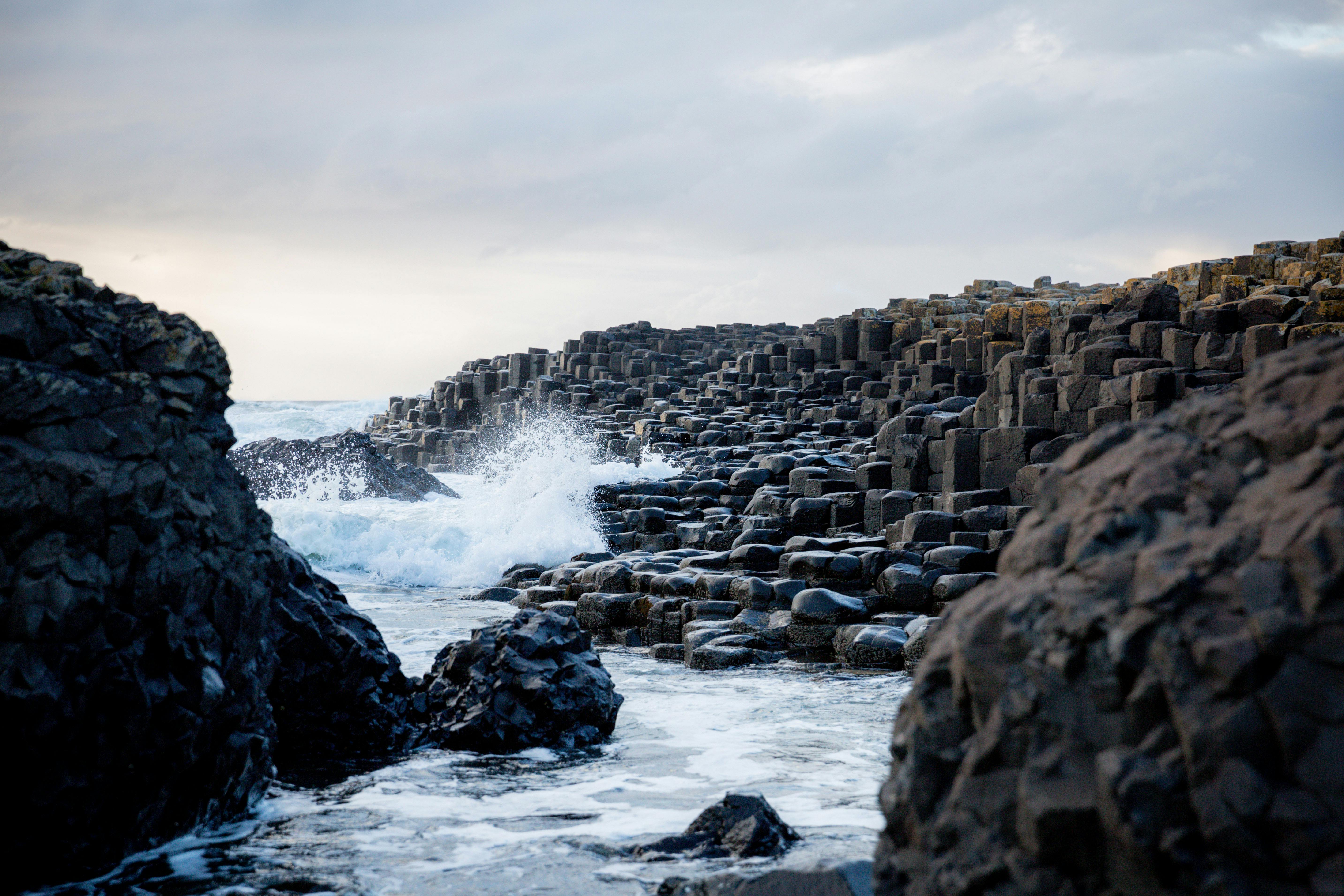Transboundary Climate Risks for the Island of Ireland (TCRII)

This article is an abridged version of the original text, which can be downloaded from the right-hand column. It highlights some of the publication’s key messages below, but please access the downloadable resource for more comprehensive detail, full references, or to quote text.
Introduction
Transboundary climate risks (TCRs) are climate risks that cross national borders (Adams et al., 2020). They can comprise (1) the transboundary impacts of climate change and (2) the transboundary effects of adaptation actions, both positive and negative, made by one or more countries, that have repercussions on other countries (Challinor et al., 2017, 2018).
Transboundary climate risks (TCRs) cross national borders and are associated with the impacts of climate change that (1) propagate through different pathways to affect other countries and regions, and (2) emerge from the effects of climate change adaptation in one or more countries and can have repercussions for others. In an increasingly interconnected world, TCRs can flow through shared ecosystems and resources (through biophysical connections), trade links (through the flow of goods and services), financial interdependencies (through the flow of capital and other assets) and people (through movement).
The island of Ireland is one of the most open economies in the world for trade and finance. While this openness has helped to generate significant wealth and improve living standards, it has also created vulnerabilities associated with being small, open and highly globalised. The Transnational Climate Impacts Index ranks Ireland 68th among the countries most vulnerable to TCRs globally. The island’s open economy, trade and finance links make it among the most vulnerable to climate change’s impacts on international trade. Coupled with this, the cross-border dimensions of climate change impacts and climate action for the island of Ireland increase the importance of collaboration across jurisdictions.
Methodology
The Transboundary Climate Risks for the Island of Ireland (TCRII) project undertook a literature review and worked with stakeholders to identify approaches for the assessment of TCRs (Chapter 2) and synergies to leverage on an all-island basis (Chapter 3), and to provide recommendations that enable emerging risks to be better accounted for, to realise the national climate objective of achieving a climate resilient economy and society by 2050 (Chapter 4).
Transboundary Climate Risk Assessment at the European level
While there is no internationally agreed framework for assessing transboundary climate risks (TCRs), but a growing number of studies are addressing the issue. Several approaches exist, including financial risk frameworks, thematic mapping of risks (trade, infrastructure, food, health, foreign policy), and risk transmission pathways such as trade, biophysical, finance, people, and infrastructure.
- The Transnational Climate Impacts (TCI) Index ranks 203 countries and shows that Ireland, usually considered low vulnerability, rises to 68th most vulnerable when TCRs are included, highlighting its exposure through international trade.
- The CASCADES Project explores how climate impacts elsewhere cascade into Europe, threatening stability, and employs multidisciplinary methods including simulations, models, and stakeholder workshops to develop responses.
- The UK Climate Change Risk Assessments (CCRA2 and CCRA3) identify seven transmission pathways—energy, finance and markets, governance, IT, goods, people, and well-being—though applying them internationally is more complex.
- The Adaptation Without Borders Initiative (AWBI) calls for global cooperation on TCRs and has developed a seven-step analytical process for assessing these risks.
- Country profiles highlight that Nordic countries (especially Finland and Sweden) are relatively advanced in assessing TCRs through trade and security impacts, while Germany has focused on quantitative studies linking trade flows and climate risks, showing significant vulnerabilities in imports and exports
Pathways of risk transfer for the Island of Ireland
Most assessments of TCRs follow similar impact pathways to identify mechanisms that can transfer climate risks from one country to another. These impact pathways can include risks related to trade, which encompasses agriculture, food supply and other commodities, and biophysical, financial, geopolitical, psychological and infrastructure-related risks. In the context of transboundary risk assessment for the island of Ireland, therefore, the risk pathways outlined by Carter et al. (2021) will be followed. These pathways can be characterised by the ways in which climate change impacts different sectors and socio-economic systems.
Trade risk pathway
This relates to the exchange of goods and services across borders, impacting agriculture, food security and other commodities. Ireland’s agri-food exports account for 90% of food production, yet the country is heavily reliant on imports, leaving it exposed to global market shocks. While Ireland is considered food secure, it is not self-sufficient, and low-income households are vulnerable to food price fluctuations. Cross-border trade is critical for both economies on the island, with a large proportion of supply chain activity involving businesses on both sides. Effective coordination between government departments north and south is crucial for managing transboundary food security and trade risks. Developing cross-border legislation and political mandates will be essential for effective collaboration on climate-related trade issues.
THE BIOPHYSICAL RISK PATHWAY
This encompasses climate impacts on biodiversity, ecosystems and natural resources, including fisheries and forestry, and the spread of invasive species. The island of Ireland is confronted with a range of biophysical risks, including transboundary threats from invasive species, infectious diseases in plants and animals, and impacts on existing water bodies and river basins. While some measures have been put in place to address these risks, they continue to pose a significant threat to the island of Ireland’s biodiversity, ecosystems and water resources. An all-island conservation strategy would provide advantages for both biodiversity and ecosystems, while also strengthening the relationship between the two jurisdictions. To effectively address and implement transboundary climate policy for biophysical risk, collaboration with existing groups and partnerships between Northern Ireland and Ireland are essential.
THE PEOPLE RISK PATHWAY
This involves changes in the movement of people in response to climate change. On the island of Ireland, the people-centred pathway is likely to encompass transboundary risks relating to physical and mental health, forced migration and displacement and tourism changes. While much of this forced migration is to neighbouring regions, a rise in migration towards Europe is anticipated. Climate change could lead to an increase in vector-borne diseases in Ireland, which can affect humans, domesticated animals and wildlife. Effectively managing and assisting migrants and/or refugees will require better domestic policy, international cooperation and collaboration at the EU level. The asylum process in Ireland may also need to include a new category for people who are migrating as a result of climate change.
THE PSYCHOLOGICAL RISK PATHWAY
This involves the psychological impacts of climate change on people’s well-being. In the context of the island of Ireland, the psychological pathway is likely to encompass transboundary risks related to the impact of climate change on mental health and well-being and to the perceived understanding of climate change as a result of various media communication channels. Ireland’s NAF briefly acknowledges the significant climate-related health and well-being impacts resulting from loss and displacement due to flooding and waterborne infectious diseases. In Ireland, residents of coastal areas prone to erosion and areas at risk of flooding should be provided with opportunities to co-design adaptation interventions and engage in decision-making processes as a response to loss of place and infrastructure.
THE GEOPOLITICAL RISK PATHWAY
This encompasses international competition for natural resources, markets and trade routes, potentially leading to new political challenges. The economies of Ireland and Northern Ireland are highly open and dependent on links with other countries for trade, and therefore face significant threats from geopolitical risks associated with climate change. Geopolitical risks are interconnected and can interact with other transboundary pathways, such as changes in population movement, biophysical risks and trade. As highlighted by Challinor and Benton (2021), the interdependent nature of the UK and Irish economies presents a significant risk to climate resilience. Brexit-related challenges could make collaboration between the jurisdictions of the island of Ireland more difficult.
THE FINANCE RISK PATHWAY
This encompasses changing capital flows in response to climate change impacts, with implications for businesses engaged in international trade, finance and insurance. Climate change poses significant risks to the island of Ireland’s financial and business sectors, particularly through the transmission of risks and impacts via the finance pathway. Flooding represents the most significant risk and has consequences for insurance, investments and mortgages. Such risks require consideration at policy level for shared river basins and catchments that are exposed to flooding risks, as well as related infrastructure in both Northern Ireland and Ireland. The implementation of the Irish government’s various plans, such as the National Retrofit Plan and the plan to deploy renewable energy technologies to Irish homes and businesses, will be crucial.
THE INFRASTRUCTURE RISK PATHWAY
This encompasses the physical infrastructure connecting countries, such as energy, transport, water and
communications networks. Critical infrastructure in Ireland, such as power stations, refineries and storage facilities, is predominantly located in coastal regions and in close proximity to rivers for ease of access. However, these locations are vulnerable to flooding due to extreme storm events, sea level rise and higher waves. Climate risks to Irish transport infrastructure include fluvial flooding and coastal flooding and erosion due to sea level rise, increased precipitation and extreme storm events, which may result in blocked or damaged transport networks. Collaborative efforts between the transport sectors in Northern Ireland, the border region and the rest of the island are necessary to ensure the resilience of cross-border transportation networks. It is crucial to ensure the resilience of networks such as the Dublin to Belfast road and rail corridors, to maintain high levels of economic and social activity.
What Makes Effective Transboundary Climate Risk Policy?
While considering TCRs is relatively new in international policy, Ireland is starting from an advantageous position, with numerous cross-border and international institutions already in place that can be utilised and learned from. For each risk pathway, work with stakeholders was undertaken to complete a first assessment of key vulnerabilities, policy levers and avenues for addressing risks. The following recommendations emerged:
- Adopt risk pathways: Recognise and adopt the seven risk pathways for assessing and planning for TCRs.
- Promote interdisciplinary research: Promote interdisciplinary research across all risk pathways, leveraging all-island research funding partnerships for cross-border collaboration.
- Leverage cross-border institutions: Engage existing cross-border institutions on an island-ofIreland scale, such as the North South Ministerial Council and the British-Irish Council.
- Involve the private sector: Encourage private sector engagement, especially in relation to the trade and finance pathways, to identify and respond to TCRs.
- Promote international collaboration: Foster international collaboration and partnerships to enhance expertise and awareness regarding TCRs, recognising that risks require global cooperation.
- Take a whole-of-government approach: Implement a whole-of-government approach, both horizontally (across sectors) and vertically (linking EU, national, sectoral and local levels), to address TCRs effectively.
- Promote local authority collaboration: Collaborate across the border at the level of local authorities, learning from Derry-Strabane and Donegal, which provide good examples of leadership.
- Integrate TCRs into national frameworks: Integrate TCRs into Ireland’s National Adaptation Framework and establish efficient links with the EU.
- Develop guidance: Develop user-friendly guidance and evaluation methods to assess and prioritise TCRs in sectoral adaptation plans
Conclusion
Addressing TCRs is critical for Ireland’s resilience to climate change. Assigning responsibilities for understanding and managing TCRs, collaboration and research are essential for adapting to climate change’s potential impacts on trade, ecosystems, people and infrastructure.
Suggested Citation
Environmental Protection Agency. 2023. Transboundary Climate Risks for the Island of Ireland (TCRII). Research Report 449. Johnstown Castle, Wexford: EPA. https://www.epa.ie/publications/research/climate-change/Research_Report-449.pdf



Comments
There is no content